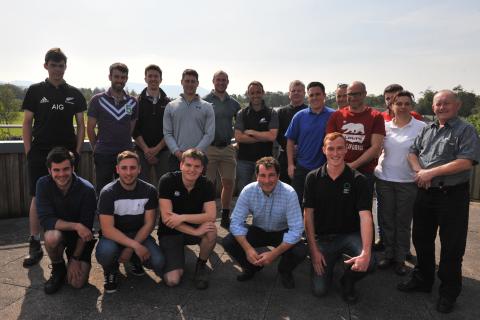21 May 2019
Grazing strategies that exploit Wales’ climate for growing grass must be a priority for livestock farmers amid demand for grass-fed sheep and beef.
Although the market doesn’t routinely reward farmers for meat qualities associated with grazing quality grass, such as high levels of important trace elements, grazing specialist James Daniel predicts that could change.
He told farmers attending an intensive two-day Farming Connect ‘Master Grass’ course that managing grazing will become ever more important, not only to reduce cost of production but to capitalise on changes to consumer eating habits and a demand for products that deliver additional health benefits.
For beef and lamb, this could come from grazing high quality pasture, said Mr Daniel, of Precision Grazing Ltd. “The market for meat is changing and grass will play an important part in this going forward,’’ he suggested.
Rotational grazing – a system of moving a group of animals through defined fields or paddocks in a planned way – is key to growing quality grass, said Mr Daniel.
Permanent and temporary fencing allows for shorter grazing periods, promoting grass growth and allowing flexibility in managing grass shortages and surpluses.
Mr Daniel advised that the first goal of grazing management is to ensure that animals consistently have enough pasture, of the correct quality, to fulfil their genetic potential for lactation or growth.
Rotational grazing allows intakes to be matched to an animal’s requirements. “Giving a ewe the run of the farm is not a productive system as she will eat a lot more than she needs,’’ Mr Daniel pointed out.
“As grass managers, use what the sheep or cattle leave behind as a guide to what they need.’’
For lamb producers, he recommends formulating a grazing calendar based around tupping. “When you mate a ewe you set in stone the timing of her needs for the year,’’ he said.
“If you mate at a time that is inappropriate for your farm you will be acquiring a lot of cost or setting yourself up for failure.’’
Ewes should be tupped to coincide with lambing in the period when a farm produces its best quality grass in the three weeks immediately afterwards. “You only get one chance at it, if the ewe doesn’t get the right quality feed in those 21 days after lambing she will have lighter lambs at weaning.’’
Feed demand is dictated by stage of production. A ewe rearing two lambs has the highest demand - 4% of her bodyweight; for an 70kg ewe that’s a daily requirement of 2.8kg of dry matter (DM).
If a 4-hectare (ha) paddock is stocked with 50 ewes it will need to grow at 35kgDM/ha/day to feed those ewes, Mr Daniel calculated. This growth is normally not seen until the end of April.
In rotational grazing systems, it is important to get the infrastructure right – each paddock must have a water supply and reliable power for sub-divisional electric fences.
With good grassland management, farmers can reduce their nitrogen (N) inputs too. N is the biggest cause of carbon emissions on a livestock farm which could have implications for the industry going forward, said Mr Daniel.
In New Zealand, livestock farmers are taxed on the volume of N they use, a system which other countries could also adopt, he warned.
Growing swards with 20-30% clover could fix 150kg N/ha per year.
Other speakers at the Master Grass event at Glynllifon College were Charlie Morgan of GrassMaster Ltd and Rhys Williams of Precision Grazing Ltd.
Farmers attending Master Grass already have plans in place to put into action on their own farms the valuable advice they gained from the course.
Mark Evans, who farms suckler beef cattle, sheep and pigs at Fferm Talyfan Fach, Llandeilo, said he had significantly improved his knowledge of soil and grass production.
“The two go hand in hand,’’ he said. “I never had a formal education in agriculture so for me the Farming Connect courses are a valuable source of information and advice.
“I attended Master Soils too, I didn’t absorb everything then so I have been able to build on it at Master Grass.’’
The course was facilitated by Gwion Parry, Farming Connect’s red meat technical officer in North Wales.
He said it had given participants the tools and the confidence to trust in the system of rotational grazing and to identify the potential of their own farms, including grass growth and stocking rates.
“The course highlighted the importance of doing the small things well. Measuring and inspecting the productivity of both your soil and pasture as well as your livestock's feed requirements, to aid the management of your business.’’
Funding for the project has been provided by the Welsh Government’s Rural Communities Rural Development Programme 2014-2020.

